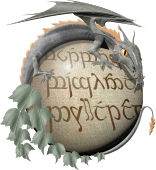- Cities and buildings
- Fields, plains and deserts
- Forests
- Hills and mountains
- Islands and promontories
- Lands, realms and regions
- Rivers and lakes
- Seas and oceans


 |
||||
|


Which personality type are you?
Take the Free mydiscprofile Personality Test to discover your core personality and your ideal job.   Which personality type are you? |
|
Dates
Emerged after the Nandor split from the Great Journey, very roughly 3,700 years before the first rising of the Moon and Sun; came under Sindarin influence and fell into decline during the Second Age; effectively extinct by the end of the Third Age
Location
Race
Divisions
Nandor and later Silvan Elves
Cultures
Galadhrim and presumably Elves of Mirkwood1
Pronunciation
na'ndorin
Meaning
The language of the Nandor ('those who turn back')
Other names
Closely connected with (and in some senses synonymous with) Silvan Elvish
Indexes: About this entry:
|
NandorinThe tongue of the NandorThe language of the Nandor, an offshoot of the Teleri who abandoned the Great Journey and settled in the Vales of Anduin. From these people the Silvan Elves of Lórien and Mirkwood were descended, and their languages were in part evolved from Nandorin (though with strong influences of Sindarin). The original speakers of Nandorin had no system of writing, and so written records are almost entirely absent, and by the end of the Third Age Nandorin as an independent language was effectively extinct. Among the very few surviving Nandorin place names are two ancient names for the land later called Lórien, which was at one time known as Lindórinand ('Vale of the Land of the Singers') and later Lórinand ('Valley of Gold'). The later form is interesting as we have both Quenya and Sindarin versions for comparison: Laurenandë and Glornan, respectively. The similarity of Lórinand to Quenya Laurenandë suggests that Nandorin changed relatively little over time, at least by comparison with Sindarin, which evolved rapidly beyond the Blue Mountains in Beleriand. A few further words survive, notably caras ('moated fortress') in Caras Galadhon, and certain historic names also seem to preserve Nandorin elements (such as Amroth and Nimrodel). In addition, a handful of words are preserved in The Etymologies (in volume V of The History of Middle-earth) but with these exceptions the language remains almost entirely unknown. Notes
See also...Indexes: About this entry:
For acknowledgements and references, see the Disclaimer & Bibliography page. Original content © copyright Mark Fisher 1998, 2001, 2013, 2016. All rights reserved. For conditions of reuse, see the Site FAQ. Website services kindly sponsored by myDISCprofile, the free online personality test.How do your personal strengths fit in with career matching? How can you identify them? Try a free personality test from myDISCprofile. |